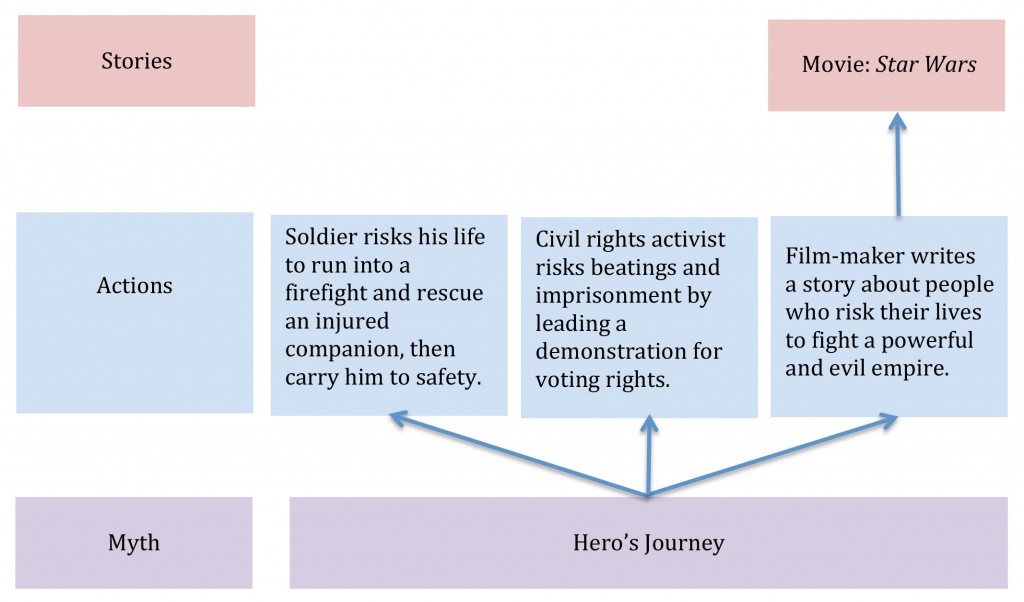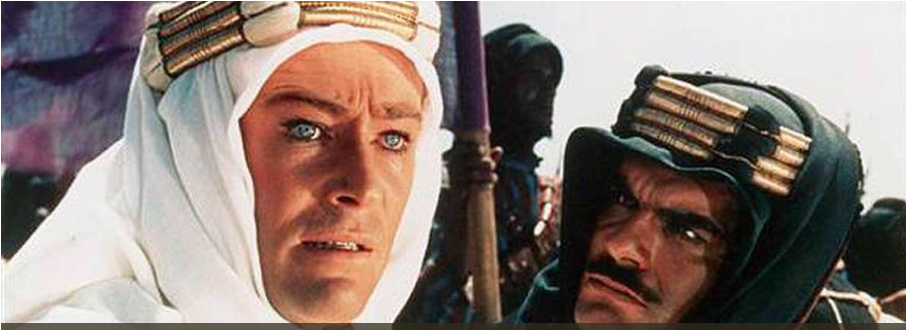Page 8 of The Mythic Roots of Western Culture’s Alienation from Nature. Adams and Belasco. Tapestry Institute Occasional Papers, Volume 1, Number 3. July, 2015. Outline / List of Headings available here.
The Relationship Between Myth, Stories, Actions, and Culture
As we prepare to define the Dark Forest, Fiery Desert Myth as a single expression of the way Western culture sees and relates to nature, it is important to reflect more deeply on the source and meaning of myth. Jung saw Myth as a product of the collective unconscious and therefore a universal human trait hard-wired by common human brain architecture.
“. . . it must be mentioned that just as the human body shows a common anatomy over and above all racial differences, so too, the psyche possesses a common substratum. I have called the latter the collective unconscious. As a common human heritage it transcends all differences of culture and consciousness and does not consist merely of contents capable of becoming conscious, but of latent dispositions toward identical reactions. Thus the fact of the collective unconscious is simply the psychic expression of identity of brain-structure irrespective of all racial differences. By its means can be explained the analogy, going even as far as identity, between various myth-themes and symbols, and the possibility of human understanding in general. The various lines of psychic development start from one common stock whose roots reach back into the past. . .Taken purely psychologically, it means that we have common instincts of ideation (imagination), and of action. All conscious imagination and action have grown out of these unconscious prototypes, and remain bound up with them.” (32)
The last point cited is very important, as it points to Myth as inspiring not only the stories people write and tell, but also the things people do in the real world. Myths are therefore expressed through a person’s’ daily life and the annals of human history that result from collective human actions, as well as in novels, fairy tales, and movies (Figure 2). As Mythologist Sam Keen wrote (ref. 22; emphasis added by the authors): “The great mono-myth of ‘the hero with a thousand faces’ . . . converts the process by which we break out of the constraints of mind and spirit imposed upon us by our society and become self-transcending persons into a dramatic narrative of a literal quest in the external world.”

Although Jung, Campbell, and Keen approach Myth as an expression of the universal collective unconscious, it’s human nature to see one’s own cultural paradigms as universally “human.” That’s because it’s nearly impossible to see the lens of cultural worldview that sits between us and the world around us, as has been increasingly documented and explored in academic disciplines ranging from phenomenology to cultural studies (33). In the Jungian “universalist” framework, The Dark Forest and Fiery Desert are merely universal archetypes: powerful symbols or metaphors that show up in the universal Hero’s Journey Myth. We have taken the approach throughout this paper that the Dark Forest, Fiery Desert Myth instead expresses only Western culture’s unconscious view of reality — which is very different from Jung and Campbell’s universal view of Myth. The idea of using cultural instead of universal interpretations for Myth analysis is not new. Deloria analyzed cultural differences between European and Native American Trickster Myths and the problems created when Jung’s Western-based interpretation was applied to Native stories in a universal way (34). More recently, the White Savior Myth has been described as an example of a Myth that expresses only Western cultural paradigms and worldview (see ref. 17).
The basic story of the White Savior Myth is that a White Hero’s journey takes him into a landscape where non-White people face injustice, danger, poverty, famine, or other threats to their well-being. His “Hero’s challenge” consists of engaging in high-risk actions that rescue them. His gained “boon” is a new trade route, the hand of a princess, access to precious resources, or even a leadership role in the non-White society. Lawrence of Arabia is commonly considered an example of the White Savior Myth. The people who live in the desert are represented as uncivilized and ineffective, despite their “natural” ability to survive in the desert. They challenge Lawrence but also need him to organize and lead them. In other words, the native inhabitants of the desert are — like the desert itself — important for the symbolic roles they play in the story. But the focus of the story is the Hero: Lawrence. He is a White, European Hero because the film was produced by and for White people of European descent. This Hero is the projection of themselves; that’s what makes the story work with its intended audience. And it’s what makes the story — both the movie and the Myth as Lawrence lived it out in real life — not very popular with people of the Middle East (35).

It’s easy to see visual expression of the White Savior Myth in stills from the film (left). But it’s essential to note that Lawrence’s white clothing and fair features are historically accurate; this image is not one cobbled up solely by film-makers. But that doesn’t mean it’s coincidence either. A number of Lawrence’s contemporaries suggested he intentionally chose white clothing to accentuate his cultural and ethnic difference from the local people. In other words, Lawrence was unconsciously aware of The White Savior Myth and living it out — expressing it in the real world. To Lawrence’s mind, this made him heroic and good. Yet, as pointed out above, his living out that same myth made his Arab allies uncomfortable. The point is that we perceive even universal myths in different ways, depending on our cultural lenses.
The Dark Forest, Fiery Desert Myth specifically expresses Western cultural paradigms about nature and the human-nature relationship. It is not universal. But it’s clear that even cultural myths have powerful roots in the unconscious mind. It is beyond the scope of this paper to explore how this is possible. It is also not our purpose to explore whether or not some Myths, such as the Hero Myth, are in fact truly universal, what kinds of cultural differences they may express (if any), and how these possibly more universal Myths relate to or partially overlap with culturally-based myths such as The White Savior or the Dark Forest, Fiery Desert. Our purpose, as stated in the Introduction, is simply to use Mythic ways of knowing to understand how Western culture thinks about nature itself and the relationship between humans and nature. That means our focus is to document the existence of, describe, and consider the consequences of the Dark Forest, Fiery Desert Myth.
Finally, it must be pointed out that Myth is not hard-wired into human behavior. Indeed, Jung and contemporary mythologists see development of the conscious self as a healthy means of overcoming the unconscious urges that arise from Mythic stories. This is not the place to explore the extensive literature that explores the relationship between biology and behavior. But it’s certainly clear that not every person of European descent “buys in to” or enacts the Dark Forest, Fiery Desert Myth, just as not every person of European descent identifies with the White Savior Myth. But it’s also true that awareness of the Myths that unconsciously inform our lives allows us to consciously turn and face them, and then to reassess our own actions in light of the assumptions and paradigms a given Myth embodies.
Continue to Next Section: Formal Description of the Dark Forest, Fiery Desert Myth
— or —
Return to: Introduction and Outline / List of Headings
References, Notes, and Credits
for
The Relationship Between Myth, Stories, Actions, and Culture
32. C. G. Jung. 1931. “Commentary.” pages 75-138 in The Secret of the Golden Flower: A Chinese Book of Life, Translated and Explained by Richard Wilhelm. Kegan Paul, Trench, Trubner & Co., Ltd. London. 151 pages. Quote cited is from pages 83-84 of the text. A PDF of this book is available online at http://www.bahaistudies.net/asma/the_secret_of_the_golden_flower.pdf. Accessed July 4, 2014.
33. It’s generally considered easier for people of non-Western cultures to gain awareness of underlying cultural paradigms for both Western and non-Western cultures simply because they must do so to navigate daily cross-cultural communication problems. People of Western culture who live and work primarily in the dominant culture and do not find themselves embedded in situations where other cultural paradigms are considered the norm do not have the same opportunity to encounter experiences that trigger paradigm shifts and stimulate reflective insight about cultural worldview.
34. Vine Deloria, Jr. 1999. Spirit & Reason: The Vine Deloria, Jr., Reader. Edited by Barbara Deloria, Kristin Foehner, and Sam Scinta. Fulcrum Publishing Co., Golden, CO. pages 17-31. Note added 1-17-16: Barbara Alice Mann keenly dissects the “universal archetype” assumed to be present in Native myths by scholars such as Joseph Campbell as well. See Mann, Barbara Alice. 2000. Iroquoian Women: The Gantowisas. (American Indian Studies, Vol. 4.) New York: Peter Lang. pp. 61-62.
35. “T. E. Lawrence from the other side,” a blog post by U.S. Air Force officer and Middle East specialist Maj. Mark Jacobson. 2012. Available online at http://buildingpeace.net/2012/06/t-e-lawrence-from-the-other-side.html. Accessed June 25, 2015. Maj. Jacobson cites supportive documentation from Our Last Best Chance: A Story of War and Peace, by King Abdullah II of Jordan (2012. Penguin Books, 400 pages). King Abdullah addresses Lawrence’s story from the standpoint of not only a Jordanian and a descendant of the people with whom Lawrence dealt, but as the great-grandson of the Jordanian King at the time of Lawrence’s exploits:
“. . . while reading King Abdullah II’s book, I discovered more clues about how Jordanians view Lawrence, although whatever truth lurks behind these quotes is diminished by the tepid tone one expects of a political memoir. Abdullah discusses the filming of Lawrence of Arabia in Jordan, then writes: ‘The film was tremendously popular in the West, less so in Jordan, where it is viewed by many people as a partial and inaccurate retelling of history. And although Lawrence is seen today by many in the West as a romantic hero who played a key role in leading the Arab people to freedom, the view in my family of the historical record is considerably more measured. My great-grandfather King Abdullah I regarded Lawrence as a “strange character,” eager to mold people to suit his interests.’ He then cites the memoirs of his great-grandfather, King Abdullah I: ‘[Lawrence’s] intrigues went as far as an attempt to influence me against my own father on the pretext that my father was obstinate… Lawrence appeared only to require people who had no views of their own, that he might impress his personal ideas upon them.'”
